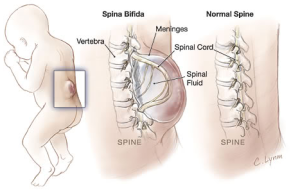Dealing with Spina Bifida as a Family

 This past spring, while chicks were hatching and new flowers were blooming, my nephew was born. Our whole family beamed with excitement as we held his tiny body in our arms. He was perfect. He still is, despite the diagnosis that came just days later; my nephew has Spina Bifida.
This past spring, while chicks were hatching and new flowers were blooming, my nephew was born. Our whole family beamed with excitement as we held his tiny body in our arms. He was perfect. He still is, despite the diagnosis that came just days later; my nephew has Spina Bifida.
Because it is the most common birth defect worldwide, many of you have probably heard of this condition. However, for those of you who hDave not, here is the scientific definition: Spina Bifida (“split spine”) occurs when the spinal column does not close all the way in development, causing the spinal cord to protrude between vertebrae. Often the spinal cord can attach itself where it is not supposed to, sometimes resulting in paralysis.
About 2 out of 1000 children are born with Spina Bifida, which may seem to leave the odds in your favor, however, this is a relatively high number compared to most birth defects.The long term effects of Spina Bifida range widely from permanent paralysis, to limited physical activity, to complete recovery.
The cause of Spina Bifida is not known and can manifest in mild or severe forms. In mild cases, the patient may not even know they have the defect until an x-ray is taken of their back for other reasons. In these cases, the defect has no effect on the patient’s way of life. In severe cases, the spinal cord does protrude and spinal fluid can build up in a tag or lump on the child’s back. In these cases, treatment is often necessary. Usually surgery is required to put the spinal cord back in place, however one surgery is not always a permanent fix and the spinal cord can be put out of place again in the future causing physical inconveniences. The most severe cases result in instant paralysis.

My nephew’s Spina Bifida was more than mild, but to the relief of all of us, not the worst case scenario. He had the little tag on his back indicating the possibility of spinal fluid, but he could move from the very first, which was the very best of signs.
While we all, immediate and extended family, lamented the possibility of future struggles this perfect little boy would overcome, we also found joy in putting our trust into his doctors and faith in God. While my nephew is still too young for us to know anything for certain about the kind of life he will lead, so far his motor-skills and physical strength have not lacked. This precious little boy is already a hero and role-model to our adoring family.
You can read stories about people living with Spina Bifida from the Spina Bifida Association here.
For more information on Spina Bifida, and to see how you can get involved, visit these links:
http://www.spinabifidaassociation.org/site/c.evKRI7OXIoJ8H/b.8028963/k.BE67/Home.htm
http://www.webmd.com/parenting/baby/tc/spina-bifida-topic-overview